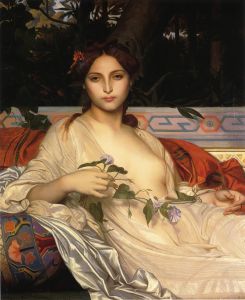
The Birth of Venus
A hand-painted replica of Alexandre Cabanel’s masterpiece The Birth of Venus, meticulously crafted by professional artists to capture the true essence of the original. Each piece is created with museum-quality canvas and rare mineral pigments, carefully painted by experienced artists with delicate brushstrokes and rich, layered colors to perfectly recreate the texture of the original artwork. Unlike machine-printed reproductions, this hand-painted version brings the painting to life, infused with the artist’s emotions and skill in every stroke. Whether for personal collection or home decoration, it instantly elevates the artistic atmosphere of any space.
"The Birth of Venus" is a painting by the French artist Alexandre Cabanel, created in 1863. This work is one of Cabanel's most famous pieces and is a quintessential example of 19th-century academic art. The painting depicts the mythological birth of Venus, the Roman goddess of love and beauty, emerging from the sea.
Cabanel's "The Birth of Venus" measures 130 cm by 225 cm and is executed in oil on canvas. The composition shows Venus lying on the waves, her body gracefully curved and her eyes closed, suggesting a serene and dreamy state. She is surrounded by playful cherubs who appear to be celebrating her arrival. The background features a calm sea and a distant horizon, enhancing the ethereal and otherworldly atmosphere of the scene.
The painting was first exhibited at the Salon of 1863, where it received significant acclaim. Napoleon III, the Emperor of France at the time, purchased the painting for his personal collection, which further elevated its status. The work is now housed in the Musée d'Orsay in Paris, where it continues to be admired by visitors from around the world.
Cabanel's technique in "The Birth of Venus" is characterized by its smooth, polished surface and meticulous attention to detail. The artist's use of soft, delicate colors and his ability to render the human form with idealized beauty are hallmarks of his style. This painting exemplifies the academic tradition, which emphasized technical skill, classical themes, and a polished finish.
"The Birth of Venus" reflects the 19th-century fascination with classical mythology and the idealization of the human form. It also embodies the academic art movement's preference for historical and mythological subjects, which were considered more prestigious than contemporary or everyday themes. Cabanel's work, along with that of his contemporaries, played a significant role in defining the standards of academic art during this period.
In addition to its artistic qualities, "The Birth of Venus" also holds cultural significance. The painting's depiction of Venus aligns with the 19th-century ideals of femininity and beauty, which were often rooted in classical antiquity. The serene and passive portrayal of Venus reflects the era's views on the role and nature of women, emphasizing grace, beauty, and modesty.
Alexandre Cabanel (1823-1889) was a prominent figure in the academic art world. He studied at the École des Beaux-Arts in Paris and won the prestigious Prix de Rome in 1845, which allowed him to study in Italy. Throughout his career, Cabanel received numerous honors and awards, and he was appointed a professor at the École des Beaux-Arts, where he influenced a generation of artists.
"The Birth of Venus" remains one of Cabanel's most celebrated works and a prime example of 19th-century academic painting. Its enduring appeal lies in its technical mastery, classical subject matter, and the idealized beauty of its central figure. The painting continues to be a significant piece in the history of art, representing the artistic and cultural values of its time.


















